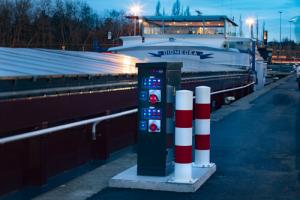The shore-based power units for inland waterway vessels are a first for Ghent. Two units have been installed at the Sifferdok’s inlet dock, and each charging point has four sockets which vessels can plug into. The shore-side power available in Ghent is 100% renewable. These shore-based power units were officially commissioned on Friday 1 March.
Fewer emissions and less noise
The shore-side power units allow inland waterway vessels to shut down their diesel engines and to take electricity from the shore instead. By doing so, the vessel is ensuring better air quality in the port and the surrounding areas, as well as reducing CO2 and dust emissions, and noise.
Use on inland waterway shipping
Inland waterway shipping is of major importance for North Sea Port. Almost half of the goods traffic between the port and the hinterland crosses the water in inland waterway vessels. North Sea Port is therefore making further efforts to make inland waterway shipping more sustainable and more user-friendly, and providing shore-based power forms part of this.
That is why North Sea Port decided to join CLINSH (Clean Inland Shipping). Partners from the Netherlands, Belgium, Germany and the United Kingdom are working together to improve air quality in urban areas by reducing air emissions in inland waterway shipping.
For the units in Ghent, North Sea Port received European grants as part of the LIFE Clean Inland Shipping project (CLINSH).
On the website
The North Sea Port website shows where the shore-based power units are located.

